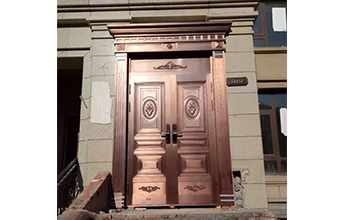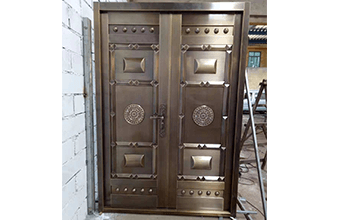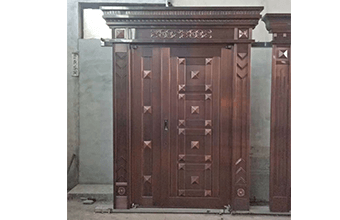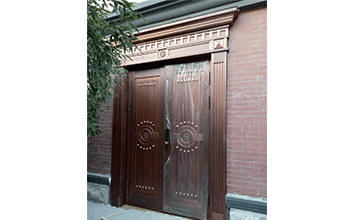分类导航
新闻
联系我们
济南宏大隆昌商贸有限公司
联系电话:15066683078
联系地址:济南市天桥区历山北路黄台装饰不锈钢市场北区28号
铜门厂家分享黄铜的硬度和用途是什么
来源:http://www.jnqianfu.com 日期:2020-11-20 发布人:admin浏览次数:0
黄铜是铜和锌的合金。如果黄铜只由铜和锌组成,则称为普通黄铜。如果这种合金是由两种以上的元素构成的,它就叫做特种黄铜。铜合金铜的合金,如铅、锡、锰、镍、铅、铁或硅黄铜具有很强的耐磨性。特种黄铜又称特种黄铜,它具有强度高、硬度高、耐化学腐蚀等特点。切削的力学性能也比较突出。黄铜无缝铜管,质地柔软,耐磨性强。黄铜无缝管可用于换热器和冷凝器、低温管道、海底输送管道。制造板材、棒材、棒材、管材、铸件等。铜在62% ~ 68%,可塑性强,制造压力设备。

Brass is an alloy of copper and zinc. If brass consists only of copper and zinc, it is called ordinary brass. If this alloy is made of more than two elements, it is called special brass. An alloy of copper, such as lead, tin, manganese, nickel, lead, iron, or silicon brass, that has strong wear resistance. Special brass, also known as special brass, has the characteristics of high strength, high hardness and chemical corrosion resistance. The mechanical properties of cutting are also outstanding. Brass seamless copper tube, soft texture, strong wear resistance. Brass seamless pipe can be used for heat exchanger and condenser, low temperature pipeline and submarine pipeline. Manufacture of plates, bars, bars, tubes, castings, etc. Copper in 62% - 68%, strong plasticity, manufacturing pressure equipment.
根据黄铜中合金元素的种类,黄铜分为普通黄铜和特殊黄铜。用于压力加工的黄铜称为变形黄铜。
According to the types of alloy elements in brass, brass is divided into ordinary brass and special brass. Brass used for pressure processing is called deformed brass.
1. 纯铜
1. pure copper
(1)普通黄铜的室温组织普通黄铜是铜和锌的二元合金,其锌含量差异很大,因此其室温组织也有很大差异。根据铜锌二元态图(图6),室温下黄铜有三种微观结构:含锌量小于35%的黄铜。含锌量为36% ~ 46%的黄铜在室温下的微观组织由黄铜+钎焊两相组成。含锌量超过46%50%的黄铜,在室温下的微观结构只包括更小的相,即黄铜。
(1) the room temperature structure of common brass is a binary alloy of copper and zinc, and its zinc content is very different, so its room temperature structure is also very different. According to the binary state diagram of copper and zinc (Figure 6), there are three microstructures of brass at room temperature: brass with zinc content less than 35%. The microstructure of brass containing 36% - 46% zinc at room temperature is composed of brass + brazing two phases. For brass containing more than 46% to 50% zinc, the microstructure at room temperature includes only a smaller phase, namely brass.

(2)单相黄铜(H96 ~ H65)的压力加工性能具有良好的可塑性,能承受冷加工和热加工,但在锻造等热加工中,单相黄铜容易出现中温脆性,具体温度范围随Zn含量变化,一般在200 ~ 700℃之间。因此,热处理温度应高于700℃。单相铜的中温脆性区主要是由于铜-锌合金相区存在两种有序化合物Cu3Zn和Cu9Zn。此外,微量的铅和铋等有害杂质在合金和铜中形成低熔点的共晶薄膜,并分布在晶界。实践证明,添加微量铈能有效中温脆性。含锌量在46% ~ 50%以上的黄铜,由于其硬脆特性,无法在压力下加工。
(2) single phase brass (H96 ~ H65) has good plasticity in pressure processing, and can withstand cold processing and hot processing. However, in hot processing such as forging, single phase brass is prone to medium temperature brittleness. The specific temperature range varies with Zn content, generally between 200 ~ 700 ℃. Therefore, the heat treatment temperature should be higher than 700 ℃. The middle temperature brittle zone of single-phase copper is mainly due to the existence of two ordered compounds cu3zn and cu9zn in the phase zone of copper zinc alloy. In addition, some harmful impurities, such as lead and bismuth, form eutectic films with low melting point in the alloy and copper, and distribute in the grain boundary. The practice shows that the addition of trace cerium can effectively eliminate the brittleness at medium temperature. Brass with zinc content of 46% - 50% or more can not be processed under pressure because of its brittleness.
(3)黄铜的力学性能,由于锌含量不同,力学性能也不尽相同,图7是黄铜力学性能随不同锌含量的变化曲线。对于rho黄铜,b和随着锌含量的增加而增加。对于(+铜焊)黄铜,室温强度不断增加,直到锌含量增加到45%左右。锌含量的进一步增加导致强度急剧下降,这是由于合金结构中存在更脆的r相(一种基于Cu5Zn8化合物的固溶体)。黄铜的室温塑性随锌含量的增加而降低。因此,含锌量大于45%的铜锌合金没有实用价值。
(3) mechanical properties of brass are different due to different zinc content. Figure 7 shows the curve of mechanical properties of brass with different zinc content. For Rho brass, B and B increased with the increase of zinc content. For (+ brazed) brass, the room temperature strength increases until the zinc content increases to about 45%. The further increase of zinc content leads to a sharp decrease in strength due to the presence of a more brittle R phase (a solid solution based on cu5zn8 compound) in the alloy structure. The room temperature plasticity of brass decreases with the increase of zinc content. Therefore, copper zinc alloy with zinc content more than 45% has no practical value.
2. 特殊黄铜
2. Special brass
为了提高铜的耐腐蚀,强度、硬度和切削用量等,添加少量的铜和锌合金(一般1% ~ 2%,3% ~ 4%的少数民族,极个别是5% ~ 6%)的锡、铝、锰、铁、硅、镍、铅和其他元素构成的三元,四元,五元合金,甚是黄铜的复杂,这也被称为特殊黄铜。
In order to improve the corrosion resistance, strength, hardness and cutting amount of copper, a small amount of tin, aluminum, manganese, iron, silicon, nickel, lead and other elements of copper and zinc alloy (generally 1% - 2%, 3% - 4% of ethnic minorities, and very few 5% - 6%) are added, which is also called special brass.
含铅黄铜:铅不溶于黄铜,以自由粒子的形式分布于晶界。含铅黄铜按其组织有两种:黄铜和黄铜。铅黄铜由于铅的有害作用,高温塑性很低,所以只能被冷变形或热挤压。含铅黄铜具有良好的高温塑性,可锻性好。
Leaded brass: lead is insoluble in brass and distributed in the grain boundary in the form of free particles. There are two kinds of leaded brass according to its structure: brass and brass. Due to the harmful effect of lead, the high temperature plasticity of lead brass is very low, so it can only be cold deformed or hot extruded. The copper containing lead has good high temperature plasticity and good malleability.
锡黄铜:锡加在黄铜中,能明显提高合金的耐热性,非凡是提高耐海水腐蚀的能力,故锡黄铜有“海军黄铜”之称。
Tin brass: in brass, tin can obviously improve the heat resistance of alloy, especially the ability to resist seawater corrosion, so tin brass has the name of "Navy brass".
锡可溶于铜基固溶体中。但随着锡含量的增加,合金中会出现脆性r相(CuZnSn化合物),不利于合金的塑性变形,所以锡黄铜的锡含量一般在0.5% ~ 1.5%之间。
Tin is soluble in copper based solid solutions. However, with the increase of tin content, brittle R phase (CuZnSn compound) will appear in the alloy, which is not conducive to the plastic deformation of the alloy, so the tin content of tin brass is generally between 0.5% and 1.5%.
普通锡黄铜有hsn70-1、hsn62-1、hsn60-1等。前者为合金,具有较高的塑性,可进行冷压、热压加工。后两种合金具有(+)两相结构,常发现少量r相。它们在室温下的塑性不高,只有在高温条件下才会变形。
Common tin brass has HSn70-1, HSn62-1, hsn60-1 and so on. The former is alloy with high plasticity and can be processed by cold pressing and hot pressing. The latter two alloys have a (+ two-phase structure and a small amount of R phase is often found. Their plasticity at room temperature is not high, and they will deform only at high temperature.
锰黄铜:锰在固体黄铜中的溶解度更大。在黄铜中加入1% ~ 4%的锰,可以在不降低合金塑性的情况下,显著提高合金的强度和耐腐蚀性。
Manganese brass: the solubility of manganese in solid brass is higher. By adding 1% - 4% manganese to brass, the strength and corrosion resistance of the alloy can be improved significantly without reducing the plasticity of the alloy.
锰黄铜具有(+)结构,常用hmn58-2,冷、热态压力加工性能相当好。
Manganese brass has a (+) structure, commonly used hmn58-2, cold and hot processing performance is quite good.
铁黄铜:在铁黄铜中,铁以富铁粒子的形式析出,使晶粒细化为晶核,防止再结晶晶粒长大,从而改善合金的力学性能和工艺性能。铁黄铜中铁的含量一般小于1.5%,结构为(+)。强度和韧性高,高温塑性好,冷态变形大。常用的是hfe59-1-1。
Iron brass: in iron brass, iron is precipitated in the form of iron rich particles, which refine the grains into crystal cores and prevent recrystallization grain growth, so as to improve the mechanical and technological properties of the alloy. The content of iron in iron brass is generally less than 1.5%, and the structure is (+). High strength and toughness, high temperature plasticity and large cold deformation. The commonly used brand is hfe59-1-1.
镍黄铜:镍和铜可以形成连续的固溶体,大大扩展了共格区。在黄铜中加入镍可以提高黄铜在大气和海水中的耐腐蚀性。镍还可以提高黄铜的再结晶温度,促进更细晶粒的形成。
Nickel brass: nickel and copper can form a continuous solid solution, greatly expanding the coherent area. Adding nickel to brass can improve the corrosion resistance of brass in atmosphere and sea water. Nickel can also increase the recrystallization temperature of brass and promote the formation of finer grains.
以上是济南铜门为大家介绍的黄铜的硬度和用途相关内容,想要了解更多内容,欢迎访问网站:http://www.jnqianfu.com
The above is the hardness and application of brass introduced by jinancopper door manufacturer. For more information, please visit http://www.jnqianfu.com
The above is the hardness and application of brass introduced by jinancopper door manufacturer. For more information, please visit http://www.jnqianfu.com
- 上一篇:铜门厂家分享黄铜的硬度和用途是什么
- 下一篇:怎样挑选别墅铜门的样式和造型?




